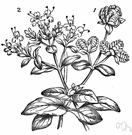For December, and January, and the latter part of November, you must take such things as are green all winter: holly; ivy; bays; juniper; cypress-trees; yew; pine-apple-trees; fir-trees; rosemary; lavender; periwinkle, the white, the purple, and the blue; germander; flags; orangetrees; lemon-trees; and myrtles, if they be stoved; and sweet marjoram, warm set.
Rosemary little; nor sweet marjoram. That which above all others yields the sweetest smell in the air is the violet, specially the white double violet, which comes twice a year; about the middle of April, and about Bartholomew-tide.
To Get Sample Copy of Report, Click here @ https://www.mrrse.com/sample/16467 Oregano essential oil -- also known by names such as wild
sweet marjoram -- is a perennial herb with origins in the Mediterranean regions.
The tender
sweet marjoram (Origanum majorana) is upright in the garden and prized by cooks but needs to be planted afresh each spring.
Comment: Marjoram or
sweet marjoram is a perennial plant of the mint family, native to eastern Mediterranean countries.
We love the size of this aromatherapy roll-on lotion, as well as its soothing blend of essential oils, including
sweet marjoram, lavender, and petitgrain mandarin.
To a safflower oil base she added
sweet marjoram essential oil for its analgesic, nervine, and vasodilator (blood vessel dilating) properties; ginger for its antispasmodic benefits; helichrysum for its analgesic, anti-inflammatory, and nervine properties; carrot seed, which is a vasodilator and smooth muscle relaxant; grapefruit for its detoxifying and emotionally uplifting benefits; vetiver, which is a deeply relaxing antispasmodic; and rose otto, distilled from rose petals, which has antidepressant and antispasmodic properties.
There are four major species of oregano, all members of the mint family--Mediterranean,
sweet marjoram, Greek oregano, and Syrian oregano--with similarities that make it difficult to distinguish among them.
It involves pouring oil or milk on the patient's forehead from a distance for a specific time period.Using essential oils like Lavender, Neroli, Sandalwood,
Sweet Marjoram and Petitgrain as part of aromatherapy treatments also has a direct physiological and psychological effect, leading to relaxation and better sleep patterns.Ayurvedic herbs used for curing insomnia include the Indian sorrel, rauwolfia, aniseed, ashwagandha, brahmi, jatamansi, lemon balm, passion flower and chamomile.Other therapies such as abhyanga and siroabhyanga help alleviate stress levels, reducing insomnia triggers.
The griffin shown here is depicted standing before a selection of flora and fauna, such as a bee, a butterfly, a pine cone, currants, a tulip and
sweet marjoram.
 sweet marjoram - aromatic European plant native to Mediterranean and Turkey; not widespread in Europe
sweet marjoram - aromatic European plant native to Mediterranean and Turkey; not widespread in Europe